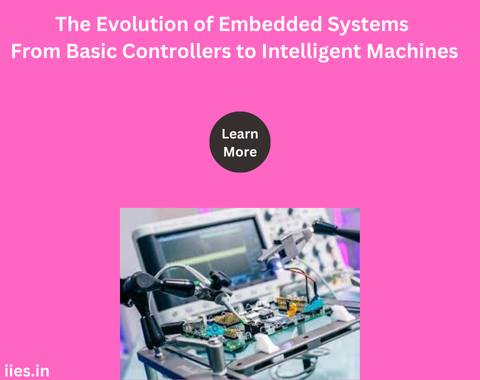
Embedded systems have quietly revolutionized the way we interact with technology. Initially used in basic control systems, they have evolved into the backbone of intelligent machines in industries such as healthcare, automotive, telecommunications, and home automation. This article explores the journey of embedded systems, tracing their transformation from simple controllers to the sophisticated, AI-powered devices of today.
The origins of embedded systems date back to the 1960s when the Apollo Guidance Computer was developed for the Apollo space missions. This early example of an embedded system was designed for a single purpose: navigating spacecraft. It set the stage for modern embedded computing by proving that compact, dedicated systems could efficiently handle real-time tasks.
In the 1970s, embedded systems gained traction with the introduction of microcontrollers like Intel’s 4004 and 8051 chips. These microcontrollers allowed developers to integrate computing power directly into devices, resulting in more compact and efficient systems for tasks like automotive control and industrial automation. The development of systems like Programmable Logic Controllers (PLCs) brought embedded computing to factory floors, ushering in the era of automation.
At their core, embedded systems consist of specific components that enable their specialized functions:
Most embedded systems operate in real-time, meaning they must respond to inputs within a strict time frame. They are also designed to be highly reliable and energy-efficient, given their continuous operation and limited power sources.
Embedded systems today are no longer isolated controllers but are increasingly becoming networked and intelligent. With the rise of the Internet of Things (IoT), devices are connected to the cloud, communicating with one another and central servers. This connectivity allows embedded systems to access and process vast amounts of data, enabling them to make smarter decisions.
A significant shift has also occurred with the integration of Artificial Intelligence (AI) and Machine Learning (ML). Once limited to simple tasks, modern embedded systems can now analyze data in real-time and make autonomous decisions. For example:
As embedded systems have grown more powerful and capable, their application across industries has expanded significantly:
Healthcare and Medical Devices: Embedded systems are central to the development of medical technologies such as insulin pumps, portable ventilators, and even robotic-assisted surgery. Their ability to process data in real time makes them invaluable in monitoring and responding to critical health parameters.
Automotive Industry: Modern vehicles contain dozens of embedded systems managing everything from engine performance to infotainment. Advanced systems like collision detection, lane-keeping assistance, and adaptive cruise control rely on real-time processing and AI-driven algorithms to ensure safety and efficiency.
Aerospace and Defense: Embedded systems are key components in the navigation, communication, and control systems of aircraft and military technology. Their real-time operational capacity and robustness make them suitable for mission-critical environments.
Consumer Electronics: From smartphones to smartwatches, nearly every modern electronic device relies on embedded systems for core functionalities such as user interface management, sensor integration, and connectivity.
Industrial Automation: Embedded systems in manufacturing enable the automation of processes through robotics, machine vision, and real-time quality control. These systems improve productivity and reduce human intervention in hazardous environments.
Despite their advancements, the design and deployment of embedded systems come with several challenges:
Security: As more embedded systems become connected to the internet through IoT, they become vulnerable to cyberattacks. Ensuring secure data transmission and preventing unauthorized access are significant concerns.
Power Management: In applications such as wearable devices or remote sensors, optimizing power consumption is critical. Energy-efficient designs and low-power processors are required to extend battery life while maintaining performance.
Real-Time Performance: For applications like autonomous vehicles or medical devices, embedded systems must operate with high precision and minimal latency. Real-time systems require careful design to ensure responsiveness under all conditions.
Complexity: As embedded systems become more integrated with AI and IoT, their complexity increases. Developers must manage hardware constraints, software optimization, and connectivity issues while maintaining reliability and safety.
Scalability: For IoT ecosystems involving thousands of devices, scalability is a challenge. Embedded systems must be designed to operate smoothly even as the number of connected devices grows exponentially.
The future of embedded systems will be marked by continued convergence with AI, IoT, and edge computing. As these systems become more intelligent, they will play a crucial role in shaping the future of autonomous systems, smart cities, and personalized healthcare. Key trends expected in the coming years include:
Edge AI: Instead of relying on centralized cloud servers, more embedded systems will process AI algorithms locally (on the edge), reducing latency and improving real-time decision-making in applications like robotics, drones, and autonomous vehicles.
5G Integration: The rollout of 5G networks will enhance the connectivity of embedded systems, enabling faster communication and more robust IoT networks.
Quantum Computing: As quantum computing technologies develop, embedded systems could harness quantum processors for solving complex problems that are currently beyond the capabilities of classical systems.
Wearable Technology: Wearables such as fitness trackers, smart glasses, and even implantable devices will continue to evolve, with embedded systems enabling real-time health monitoring and augmented reality experiences.
The evolution of embedded systems from basic controllers to intelligent, connected devices represents one of the most significant technological advancements of our time. As these systems continue to integrate AI, IoT, and other emerging technologies, their role in shaping the future of industries and everyday life will only grow. For developers, engineers, and businesses, staying on the cutting edge of embedded system innovations will be essential in driving the next generation of technological breakthroughs.
Indian Institute of Embedded Systems – IIES